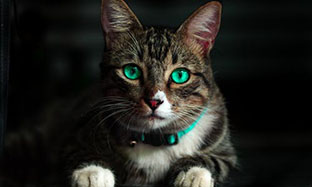
Cat's body language
Most of us, as cat parents, certainly believe that our cats have feelings. But ever wondered what exactly do they really feel? Is your cat sad or does your cat sound happy? If you have cats as pets, read on to understand your cat’s body language and its underlying feelings.
What emotions do cats feel?
Cats like their wild ancestors were designed for solitary living and hence are believed to lack the entire range of emotions that are essential for communication in more social and group-living animals like dogs, monkeys and humans.
While cats do not feel the entire array of emotions like jealousy, anger, disgust, etc. like we humans do, they well experience several important feelings that help them survive and cope best in their environment. These include certain negative feelings and certain positive feelings.
Makings of a sad cat: What are the negative emotions a cat feels and the resultant cat’s body language?
Negative emotions that cats feel in response to stress-causing factors in their environment:
1. Fear-Anxiety – often felt when threatened by something unfamiliar, for example, the presence of an unfamiliar cat in the neighbourhood or by the arrival of guests at home.
Cat’s body language: Either one of these three ”Fs” may be observed: i) Flees to avoid the situation, ii) Freezes by sitting in a quiet, crouched posture (body and head pulled close together, with all four feet planted firmly on the ground), iii) Fights back by hissing or growling and trying to scratch or bite. A fearful cat will have its ears flattened downwards with eyes widely opened or firmly pressed shut.
2. Frustration – often felt when something a cat desires is not achieved or received. For example, not being given food when demanding for it or being denied access into a room a cat most favours.
Cat’s body language: When frustrated a cat’s body language is geared towards getting attention to what it desires. Hence a frustrated cat may be aggressive, meow loudly and persistently, be noisy, be active like excessive pacing, pawing, rubbing and at times can redirect the aggression towards anyone in its path by scratching or biting.
3. Panic-grief- most often felt by kittens when separated from the mother or by the mother when separated from her kittens.
Cat’s body language: Persistent meowing, desperately seeking behaviour
4. Pain – associated with any physical ailment or medical health condition
Cat’s body language: Either one of the two – i) Quiet & withdrawn, shying away from touch or ii) More irritable, trying to bite or scratch when touched, persistent meowing
With cats as pets, it’s important to be observant and aware of your cat’s body language. The moment you suspect your cat to be feeling any of the above emotions, it is vital to minimize or remove the stress-causing factors that aggravate negative feelings.
Makings of a cat sounding happy: What are the pleasurable behaviours a cat that is feeling positive will indulge in?
1. Seeking: Demonstrating exploratory behaviour to meet key needs such as, seeking a cosy place to rest, searching for a mate in unneutered cats, etc.
2. Comfort and consumption: These are associated with pleasant experiences that are result of consuming food or water, when hungry and thirsty or the comfort derived from being stroked by the pet parent. These feel-good sensations are a reflection of a cat’s positive state of mind.
3. Lust: The need to find a suitable mate to continue one’s species
4. Play: A very important behaviour in especially the young that develops appropriate social communication skills with each other.
A sad cat will almost never demonstrate pleasure-deriving behaviours such as playing, consuming food, etc.
With cats as pets, the aim should always be to boost positive feelings and keep stress-causing agents that result in negative feelings to a minimum!
Take a look at our dry cat food range.

